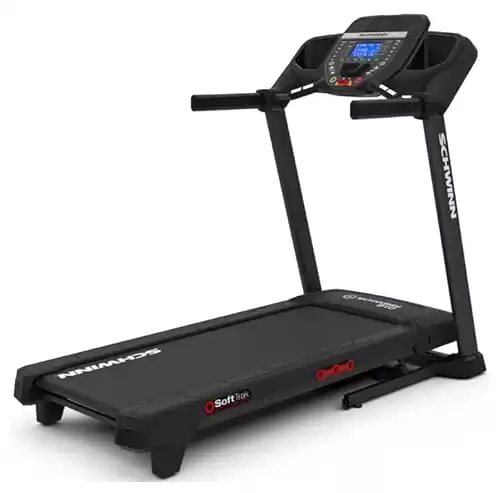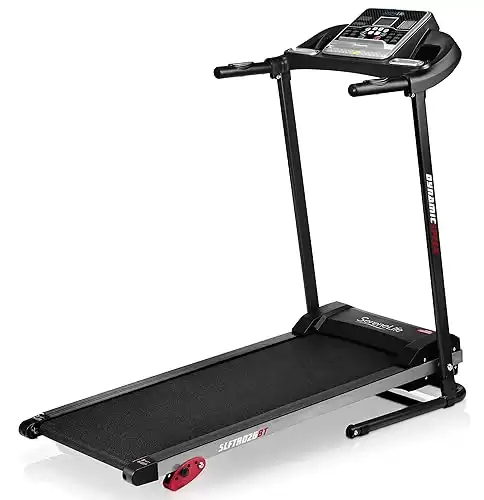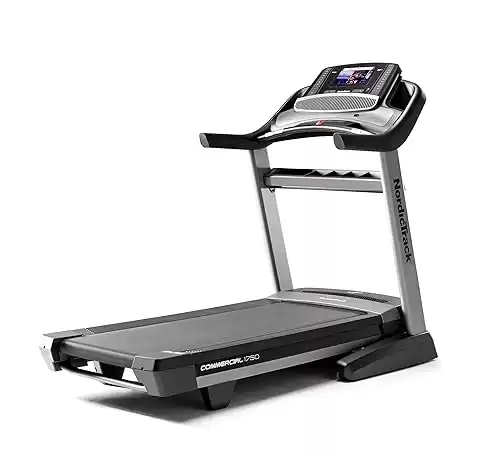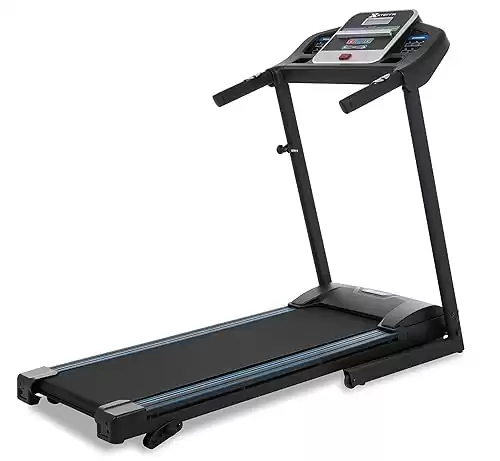Treadmills come in all shapes and sizes. From the smallest on the market to the bulkiest possible choice, they all have their place. Furthermore, each side of the spectrum has its pros and cons. So, let’s take a look at how much treadmills weigh. As well as what causes weight differences and why it matters.
The average manual treadmill weighs around 60 lbs (27 kg) while one with a motor is about 210 lbs (95 kg).
There are several factors that go into how much a treadmill weighs. However, the primary factor is the power and size of the motor. Bigger more powerful motors usually cause the weight to be higher. With that said, this is not an absolute rule. Let’s look at a few examples of popular models and their specifications. As well as why it may be useful to have such info.
Table Of Contents:
- Why The Weight Of A Treadmill Is Important
- What Factors Effect A Treadmills Weight?
- Types Of Treadmills
- Pros And Cons Of Treadmill Weight
- Should You Buy A Treadmill Based On Weight?
- Examples Of Electric Treadmill Weight By Make & Model
- Examples Of Manual Treadmill Weight By Make & Model
Why The Weight Of A Treadmill Is Important
“How much do treadmills weigh?” is not a question people usually consider, until it’s too late. There are quite a few scenarios where it could be crucial information. Let’s take a look at a few of the situations where you may wish you’d have asked “How much do treadmills’ weigh?”
- Determining how big of a vehicle you’ll need to move it
- Finding out if it’s safe to operate on a 2nd or 3rd floor or porch
- Attempting to move the treadmill from one location to other
- Getting a general idea of how much weight the treadmill will hold
- Determining how easy or hard it would be to relocate
- Calculating shipping costs
What Factors Effect A Treadmills Weight?
There are a few factors that contribute to the weight of a treadmill. First, to some degree, would be the overall size of the treadmill. Next, and perhaps the biggest factor, is the size of the motor within the treadmill.
Generally, the bigger and more powerful the motor, the heavier the treadmill will be. A third and final factor contributing to how much a treadmill weighs is the material the treadmill pieces are made from.
There are treadmills on the market designed to be as light as possible without sacrificing much size or power, however, they usually come with a higher price tag.
Types Of Treadmills
- Manual treadmills: 60 lbs (27 kg)
- Motorized treadmills: 210 lbs (95 kg)
- Folding deck treadmills: 200 lbs (91 kg)
- Commercial treadmills: 300 lbs (136 kg)
Manual Treadmills
Average Weight: 60lbs
Manual treadmills don’t contain motors. Instead, the movement of the person’s legs moves the belt. These are usually the smallest and lightest treadmills available. However, they are also very basic and lack many of the advanced features that you’d expect from a treadmill. For example, they don’t feature any screens or programmable settings.
Furthermore, most manual treadmills have a maximum speed of about 4 miles per hour. Meaning they are only suitable for a brisk walking pace, which is not ideal for many users.
| Pros | Cons |
| Simple to use | Very low run/walk speed |
| Light, portable, and easy to move | No performance tracking technology |
| Cheapest treadmill options | No screens or programmable settings |
| Requires no power |
Motorized Treadmills
Average Weight: 210lbs
Motorized treadmills have a built-in motor that turns the belt. As a result, they can achieve much higher speeds than manual treadmills. They are also substantially heavier in most cases. Furthermore, the bigger the motor is, the heavier the treadmill generally is.
Due to their increased power, they can usually reach speeds of around 10 miles per hour. The general user will find this a much more practical option than a manual treadmill.
Lastly, many motorized treadmills contain an LED screen and several programmable settings. As well as things like “incline” settings which imitate running uphill.
| Pros | Cons |
| Higher speed capability | Requires power for use |
| Can feature screens, technology, and performance tracking | More expensive than manual treadmills |
| Higher weight capacity | Takes up more space |
| Larger and more comfortable | More expensive than manual treadmills |
Folding Deck Treadmills
Average Weight: 200 lbs (91 kg)
Folding deck treadmills are designed to be as compact as possible. As a result, the base folds upward and locks in place for storage. Folding treadmills do have motors but they are usually on the smaller side. Furthermore, the materials from which they are designed are often times lighter than heavier, more commercial units.
Folding treadmills are a good balance between power, size, and storability. Considering they have smaller motors and a minimalistic design they are often cheaper than other treadmills, at the cost of some features, power, or overall durability.
| Pros | Cons |
| Smaller than traditional motorized treadmills | Less durable |
| Compact | Fewer power capabilities |
| Can still feature high-speed/power options | |
| More budget-friendly |
Commercial Treadmills
Average Weight: 300 lbs (136 kg)
Commercial Treadmills are the ones you see when you go to the gym. They are usually the heaviest treadmills on the market as well. This is mainly because of their larger motors, which allow for faster speeds. They are also constructed of heavier, sturdier materials, so they are more durable. As well as capable of holding more weight.
These are also the most technologically advanced treadmills. Often featuring large LED screens, Bluetooth speakers, a number of programmable settings, and things that monitor performance, such as heart rate and calories burned. This, coupled with their sturdy build and large motors make them the heaviest on the market.
| Pros | Cons |
| Most powerful units available | Takes up the most space |
| Most technologically advanced | Hard to relocate |
| Best performance tracking | Very expensive |
Pros And Cons Of Treadmill Weight
Heavy Treadmills
| Pros | Cons |
| More powerful motor | Harder to store |
| Larger belt/running area | Takes up more room |
| Made from sturdier material | Harder to relocate |
| More horsepower and speed | Must choose placement area carefully |
| Can hold more weight | More expensive than lighter treadmills |
Lighter Treadmills
| Pros | Cons |
| Takes up less space | Less powerful motor |
| Can more easily be relocated | Less horsepower |
| Usually cheaper than heavier models | Typically smaller belt/run area |
| Quieter | Built from less durable materials |
| More versatile placement options | May have fewer technology/features |
| Can not hold as much weight |
Should You Buy A Treadmill Based On Weight?
There are quite a few reasons why you’d want to take the weight of a given treadmill into account. For example, if you need a very powerful treadmill or one that holds a higher amount of weight, you’ll probably end up on a heavier model.
On the other hand, if you are tight on space, or will need your treadmill to be easily portable/storable you’ll probably naturally land on a lighter model.
With that said, there are several other stats that you’d need to look at besides weight. So, you probably shouldn’t buy based on weight alone. Let’s take a look at some other important numbers.
Important numbers besides weight
If you feel you need a heavier treadmill there are probably some underlining requirements that make that the case. Aside from “it needs to be heavy.” For example, you may need a particularly spacious or powerful treadmill.
Treadmills with these features will likely be heavier. However, this won’t always be the case. So, here are a few other important numbers to consider when shopping around.
- Tread Belt Size: This will usually be written as “inches wide” by “inches long” (So for example 22” x 60”) and represents the size of the running area.
- Weight Capacity: This will usually be written as a single number, in pounds (such as 300-pounds), and is the maximum weight the unit can safely handle.
- Maximum Horsepower: This is the horsepower of the motor at its fastest setting. The higher the horsepower, the faster the top speed will be
- Top Speed: This number will usually be written in miles per hour and represents the maximum speed the unit can reach.
- Item Dimensions: These numbers are often written as length, width, and height (or 78.8 x 39.2 x 63 inches for example) and represent the overall size of the unit as a whole.
Be sure to consider all the factors that may cause you to be asking “how much do treadmills weigh?” and take these other numbers into account as well.
Examples of Electric Treadmill Weight By Make & Model
One of the best ways to answer “How much do treadmills weigh?” is to take a look at the numbers. Below is a list of popular motorized treadmills and their weight, horsepower, and speed.
| Treadmill Model | Weight | Motor & Horsepower |
| Commercial 1750 Treadmill | 346 Pounds | Maximum Horsepower – 3.75 Horsepower Speed Rating – 12 miles per hour |
| Commercial 2450 Treadmill | 339 Pounds | Maximum Horsepower – 4 Horsepower Speed Rating – 12 miles per hour |
| Commercial 2950 Treadmill | 360 Pounds | Maximum Horsepower 4 Horsepower Speed Rating – 12 miles per hour |
| Horizon Fitness T101 Foldable Treadmill | 180 Pounds | Maximum Horsepower – 2 Horsepower Speed Rating – 10 miles per hour |
| Horizon Fitness T 6.5 Si Treadmill | 198 Pounds | Maximum Horsepower – 2.6 Speed Rating – 10 miles per hour |
| XTERRA Fitness TR150 Folding Treadmill | 108 Pounds | Maximum Horsepower – 2.25 Horsepower Speed Rating – 0.5-10 miles per hour |
| XTERRA Fitness TR300 Folding Treadmill | 207 Pounds | Maximum Horsepower – 2.25 Horsepower Speed Rating – 10 miles per hour |
| XTERRA Fitness TRX3500 Folding Treadmill, Silver | 213 Pounds | Maximum Horsepower – 3 Horsepower Speed Rating – 12 miles per hour |
| Sunny Health SF-T7955 | 166 Pounds | Maximum Horsepower – 3 Horsepower Speed Rating – 11.5 miles per hour |
| Sunny Health SF-T4400 | 103 pounds | Maximum Horsepower – 2.2 Horsepower Speed Rating – 9 miles per hour |
| Sunny Health 7750P | 127 pounds | Maximum Horsepower – 2.5 Horsepower Speed Rating – 8 miles per hour |
| Sunny Health SF-T7917 | 148 pounds | Maximum Horsepower – 2 Horsepower Speed Rating – 10 miles per hour |
Sunny Health SF-SF-T760 | 103 pounds | Maximum Horsepower – 2.2 Horsepower Speed Rating – 9 miles per hour |
Examples Of Manual Treadmill Weight By Make & Model
Manual treadmills are substantially lighter than their motorized counterparts. Let’s answer “how much do treadmills weigh if they’re manual?”
| Treadmill Model | Weight |
| Progear 190 | 49 Pounds |
| Sunny Health SF-T7723 | 110 Pounds |
| Sunny Health SF-T1407M | 46 Pounds |
| Exerpeutic 100XL | 73 Pounds |
| Confidence | 47 Pounds |
| Phoenix 98510 | 45 Pounds |
How Much do Treadmills Weigh At Their Heaviest?
So far, when answering “how much do treadmills weigh?” we’ve looked mostly at averages. So, just how heavy can treadmills get? Well, let’s take a look.
The heaviest treadmill I could find on the market was the “Life Fitness Platinum Club Series Treadmill” which weighs in at a unit weight of 444 pounds.
It’s one of the most advanced treadmills on the market and is quite close to commercial grade. It’s also incredibly heavy-duty and has one of the highest weight limits on the market. While it is a beast of a treadmill it comes with a price tag that reflects its high quality.
How Much do Treadmills Weigh At Their Lightest?
Now let’s look at the other end of the spectrum and answer “how much do treadmills weigh at their lightest?” This section will exclude manual treadmills without motors.
With that out of the way, the lightest electric treadmill I found is the “Exterra TR150.” The TR150 weighs in at an overall unit weight of 108 pounds. If you checked out the table above, you know just how light this is for a motorized treadmill.
For those who didn’t, the average weight for a motorized treadmill is around 200 pounds. So, the Extera TR150 cuts nearly 50% off of the average weight for it’s caragory.
Not only is it quite light it also features an impressive 2.25HP engine and a 250 pound weight limit. These are quite good stats given the unit’s overall weight.
Conclusion
There is a multitude of different things that factor into answering the question “How much do treadmills weigh?” The weight of each treadmill is changed by its type, purpose, material, and motor.
Furthermore, there are just as many reasons why the weight of a treadmill would be important. Regardless of why you asked the question, I hope you have found your answer here today.






